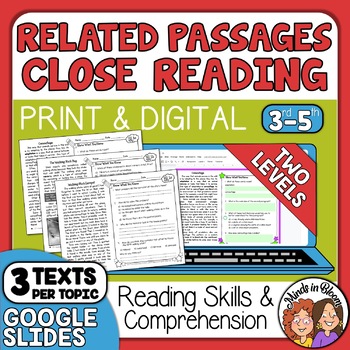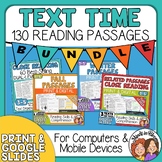Close Reading Comprehension 3-Paired Passages and Questions - 2 Reading Levels
- PDF
- Google Apps™

What educators are saying
Also included in
- Dig deeply into the text for comprehension and close reading practice with these high-interest, standards-based reading passages written by a published nonfiction children’s author. Each of these 130 passages is presented at two reading levels (3/4 and 4/5). The Show What You Know, text-dependent quPrice $49.99Original Price $58.92Save $8.93
Description
While these close reading passages can be used independently, they were written to be used to compare and contrast in pairs or all three together.
There are 30 passages, each presented at two reading levels (grades 3-4 and 4-5) for a total of 60 passages - all written by an experienced and published nonfiction children's author. You also get a variety of graphic organizers to help students compare the passages.
WHAT’S INCLUDED:
✍️ PRINT:
- 30 printable passages with comprehension questions (Each with 2 levels! 120 passages total.)
- Annotation Guide (prints 2 to a page)
- 3 different formats for comparing and contrasting two related passages
- Chart
- Graphic Organizer
- Written Response
- 3 different formats for comparing all three related passages
- Chart
- Graphic Organizer
- Written Response
- 4 pages to guide students in writing an informational paragraph using facts gathered from their reading
- Taking Notes
- Organizing
- First Draft/Editing
- Final Draft.
DIGITAL:
- Google Slides Activity
DIFFERENTIATION OPTIONS:
- Digital or Print
- Differentiated Text (2 options)
- Multiple versions of the recording sheet included
Great for 3rd, 4th, or 5th grade!
CHECK OUT THE PREVIEW TO SEE A LOT MORE!
This resource is part of a money-saving bundle!
NOTE: This resource uses American English and is not editable.
The passages are science and social-studies based to dovetail into your curriculum. The included text-dependent questions address a variety of close reading skills.
The Show What You Know, text-dependent questions are identical for both reading levels. This allows you to discuss the passages altogether, even if you have students using different reading levels. Note that some questions may be challenging for third-grade students, especially near the start of the year.
The passages are sequenced in cycles of three. The three passages all focus on related topics. Each of the three passages can be identified with the same number, but a different letter as follows:
IT: Informational Text (nonfiction) – this is usually an overview of the topic.
IT: Informational Text (nonfiction) with an illustration such as a map, chart, photo, diagram etc.
L: Literature (fiction) – this is a story or other fictional passage related to the topic.
The skills addressed in each passage are written in small print in the bottom left margin and in the table of contents for easy reference. The skills address most of the RI and RL Common Core Standards and include:
- reading for details, main idea, summarizing, paraphrasing, inference, genre, setting/character/plot, theme, context clues/vocabulary, figurative language, author’s style, author’s purpose, point of view, mood/tone, text structure, text features, comparing and contrasting, interpreting an illustration (map, chart, diagram, table, or photo), analysis, and evaluation. These skills are also listed in the Table of Contents for easy reference.
These passages could be used for morning work, at a center or station, as part of a reading packet, with a small group, as homework, as enrichment for younger, highly capable students, as remediation for struggling students, or as test prep. For interactive notebooks, just cut the two sections apart.
Here’s what teachers are saying:
✏️ "My students enjoyed the passages and questions or morning work. I found this purchase to be most helpful because we are working on informational text and analyzing informational text including text features. I like that the passages are short yet grade-level appropriate, offer the opportunity to work on context clues for unknown words, and are in line with what we are currently doing in our class. Thank you for making this my students and I appreciate it very much." -Chevon W.
✏️ "I use this resource for virtual differentiation. It worked very well because of the two levels of text and additional options such as contrast and compare graphic organizers for paired passages. These added elements made it easy for me to gear up the lesson for my higher ability students." -The Glitzy Game Girl
✏️ "As a teacher I love all of your resource packets. The stories are always highly engaging and the students love finding their 'evidence' in the passages. I like that your resources contain both multiple choice questions and short answer responses. Great resource." -Lisa B.
____________________________________
Be the first to know about discounts, freebies and new resources!
- Follow us on TpT.
- Join our Teachers Club.
- Check out our Blog www.Minds-in-Bloom.com
- Follow us on Social Media - Facebook or Instagram
Get TPT credit to use on future purchases:
- Go to your My Purchases page.
- Click on the Provide Feedback button to leave a rating and a short comment.
- You’ll earn TPT credits, which you can redeem on future purchases!
⭐⭐⭐⭐⭐ WE STRIVE FOR 5 STARS! ⭐⭐⭐⭐⭐
NEED HELP? Before leaving feedback:
- Visit the FAQs section
- submit a help ticket
- ask a question on the Q& A tab
About the Author
Rachel Lynette is a published author of over 120 nonfiction books for children on a variety of subjects, as well as several teacher resource books. She has written for publishers such as Harcourt, Thompson-Gale, Rosen, Children’s Press, Evan-Moor, Kagan, and several others. This resource reflects more than a decade of professional writing experience.
Terms of Use
This resource was created by Rachel Lynette and Cassi Noack for Minds in Bloom INC., all rights reserved. It may be used by the original purchaser for single class use only. Teachers may distribute this product in email, through google classroom or over the Internet to their students (and parents) as long as the site is password protected. In other words, you may distribute it to your own students, but may not put it on the Internet where it could be publicly found and downloaded.
If you want to share this resource with colleagues, please purchase additional licenses from TpT. Thank you for respecting these terms of use.
This product is happily brought to you by Rachel Lynette and Cassi Noack of Minds in Bloom.
SKU: 3648649






